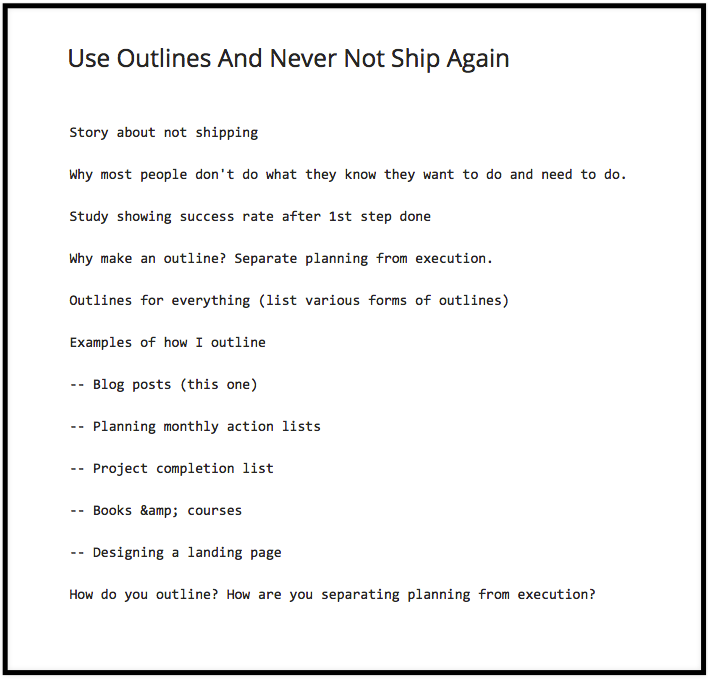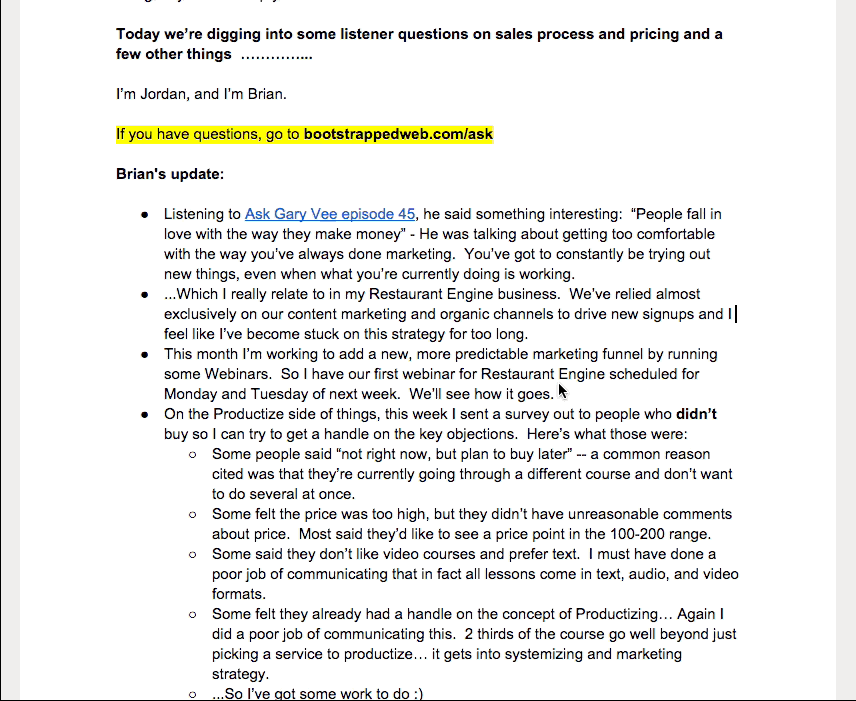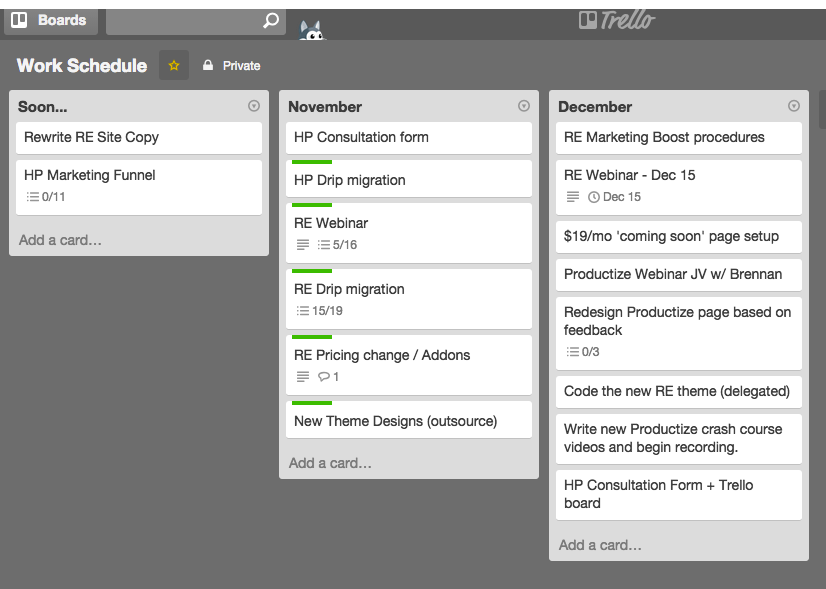Use Outlines And Never Not Ship Again
Everyone has something BIG that they wish they could achieve… Someday. The vast majority never even tries.
Of course, you and I, we’re not everyone. We do try. We convince ourselves that we will make that big thing happen. We see others who’ve done it. We know how it can be done. So we can do it too. We will do it…
“Tomorrow… When I’m in a more productive mood.”
“Next week… When it’s not a holiday week.”
“Next month… After this client project wraps up.”
“Next year… After I quit my job and have more time.”
There are a thousand reasons why we procrastinate. But 999 of them don’t touch on the real reason why we choose not to do things — even when we want to do them, need to do them, and know exactly how to do them. We just don’t.
The real reason why procrastination holds us back from shipping that next big thing is we get overwhelmed.
That next big thing is so big, so complex, so challenging, that we get lost once we start thinking about all that’s involved. So many steps. So many choices and priorities to sort through. There’s so much work ahead of us that our brains get tired just thinking about it.
And that’s the moment when we’re most vulnerable.
When we’re intimidated and overwhelmed by what’s standing in between today and a finished, shipped product, we begin to doubt ourselves. Like, what if I screw something up? What I lack the skills or talent required? What if somebody beats me to it?
And there you have it. The reason why most big things never even happen.
Crippled by Choices
In the New York Times Magazine piece by John Tierney, Do You Suffer From Decision Fatigue?, this phenomenon is described as follows:
Decision fatigue helps explain why ordinarily sensible people get angry at colleagues and families, splurge on clothes, buy junk food at the supermarket and can’t resist the dealer’s offer to rustproof their new car. No matter how rational and high-minded you try to be, you can’t make decision after decision without paying a biological price.
In other words, the more choices we’re faced with, the less effective we are. With every decision, we expend a bit more mental energy. Over the course of a day (or any compressed period of time), we deplete ourselves of this energy until finally, we give in.
We look for shortcuts, as the piece goes on to describe:
The other shortcut is the ultimate energy saver: do nothing. Instead of agonizing over decisions, avoid any choice. Ducking a decision often creates bigger problems in the long run, but for the moment, it eases the mental strain. You start to resist any change, any potentially risky move.
As entrepreneurs, we’re already susceptible to decision fatigue from the day-to-day grind of business as usual. So when we come upon that next big thing to go after, too often we stop before we even start.
The trick is to find a way to leapfrog past that initial honeymoon phase, when you’re both excited about the possibilities, but overwhelmed by choices and next steps. You have to hit the fast forward button and jump into the productive, creative work as quickly as possible.
The Outline
The outline is your shortcut.
It’s your shield from the overwhelming jumbled mess of choices, steps, and directions that you might pursue as you set out on this big journey ahead. Without your outline, you’ll stare at a blank page. Files never published. Product never shipped. Customers never acquired.
It’s not that skipping the outline will cause you to fail. You won’t have a chance to fail. Without an outline, you’re setting yourself up for inaction.
Separate Planning From Execution
The content of the outline in and of itself isn’t all that important, really.
What matters here, is the why behind using an outline to ship your next big thing: Your outline helps you separate the planning from the execution.
When you have your outline in hand, you’ve got your plan. You’ve got the steps all laid out. The system. It has been thought through, strategized, and refined. It’s primed and ready to be put into action. Now you simply need to start at the top and work your way through it.
In Tim Ferriss’ recent podcast episode about decision fatigue (it was here that I came across the NYT article I quoted above), he gives a great bit of advice for having a super-productive morning: Plan your morning the night before, so that you don’t have to expend any mental energy whatsoever on the menial tasks of getting yourself up and ready for the day.
I’m starting to use this for getting my out-of-shape ass to the gym in the morning. The night before, I set aside my running shoes, workout shorts and shirt, and I even queue up my workout playlist in Spotify. If I have to delay getting to the gym because I’m searching the house for my favorite workout shorts, or scrolling through my playlists to find the right one, then I’m much more likely to just say “screw it” and hop back into bed.
So by making an outline, you’re setting yourself up for action. You’re separating the planning (the outlining stage) from the execution (the production work).
But what about making that outline? When you’re starting from nothing (except for your one big idea), how do you even begin? Can’t you get caught in that decision-fatigue trap while you’re here in the outlining stage?
Yep, you can. But when you acknowledge that separation between planning and execution, all of a sudden your task at hand becomes completely manageable, even enjoyable.
When you’re starting from nothing, your only objective is to make your plan. That’s it. You’re not coding, not writing, not designing, not wireframing, not doing customer development, not marketing… None of that.
All you’re aiming for right now is a finished plan. Your outline. It will only take you a day, or a week at most, to complete. When it’s done, you will have accomplished the most meaningful, make-or-break step in this entire journey. After that, you’re ready to take action and execute.
Types of Outlines
When we think of an outline, we typically think of it’s most common use-case, writing. It’s absolutely essential for any writing project to begin with an outline.
I didn’t always use outlines for my articles on this blog. But since I made a habit of starting with an outline for every article this past year, I feel my writing gained a better focus and resonated more.
Here’s the outline I used for this very article before I fleshed it out:

The outline I created before writing this article that you're reading.
But I think of outlines in a much broader sense. These days, I start with an outline in just about anything I do.
Here are various types of outlines that come to mind:
- Talking points for a podcast episode / interview
- Planning monthly action lists
- Project completion lists
- Creating a course or writing a book
- Designing a landing page
Examples
I showed you an example above of how I start with an outline before writing any article on this blog. Now let’s look at a few other examples of how I use outlines to guide the things I work on:
Podcast episode talking points
On Bootstrapped Web, the podcast that I co-host with Jordan Gal, we enjoy loose conversation just as much as the next podcasters. But we still spend a lot of time on crafting a solid outline of talking points. Sometimes our outlining sessions last longer than the recording.
How does an outline improve the quality of a podcast? Again, it comes down to separating the planning from execution.
During the podcast recording, we want to avoid having to think on the spot and come up with insightful topics of conversation. We speak off the cuff quite a bit, but the high-level topics are planned ahead of time.
It also helps us create a sequence that benefits the listener. For example, in episode 47 we talked about business models for bootstrappers. In our outlining session, we decided it would be best if we approached this topic in a chronological order, matching the right business model to the right phase in your bootstrapping career.
Here’s a look at our outline from episode 50:

The outline we used for Episode 50 of Bootstrapped Web.
Monthly action lists
Writing an outline for content is very much like planning your overall workload for the coming month(s). The same concept and the same benefit apply.
By outlining your upcoming month(s) work, you’re removing the critical decisions of “what should I work on today” from your day-to-day, and spending just one day per month giving that question the thought and strategic thinking that it deserves.
When you’re planning your work ahead of time, you can be sure you’re working on the right things so that you’re making meaningful progress from month to month.
For the past year, I’ve been diligent about listing out the handful of things I plan to tackle on a monthly basis. Around the 1st of every month, I come back to my Trello board, which I titled “Work Schedule”. It consists of 3 lists:
- “Soon…” – Things that won’t be getting done right now, but also can’t be left on a “Someday” (a.k.a. “never”) list. I’ll move these into an upcoming month soon. They’re here, so that they remain on my mind.
- This month – Things that will be actively worked this month. My goal is to work on — and ship — everything on this list during the next 4 weeks.
- Next month – This list is not finalized (until next month arrives). But right now I’m acknowledging a few things that are “on deck”.
Here’s what my “Work Schedule” board looks like right now:

Most people focus on this month’s to-do list, and what’s getting done right now.
But I think the “Soon…” and Next Month lists are even more important. Without making these lists, it’s easy for those items to creep into this month’s work schedule. Every to-do is mission-critical and there’s always more things to get done than days in the month. That feeling of urgency can cause you to shift your schedule around haphazardly, at the expense of what you originally planned.
So by acknowledge those items that you’ll get to soon, just not right now, you’re able to shortcut that urgency effect, and remain focused on your tasks at hand with the comfort of knowing those other pieces will fall into place later as planned.
Books & Courses
When it comes to creating educational products, the outline is, of course, an essential first step.
When planning my book, Design For Conversions, I created 3 completely different outlines. Each was a re-write that changed the entire focus of the book. Had I gone straight into writing the chapters without creating — and completing — the outline first, I’m certain the project would have had one of two possible outcomes: Either I’d finish writing a book that lacked a cohesive structure and compelling value, or due to a lack of focus I’d burn out and never finish it. The outline ensured that I not only shipped the product, but ended up with the book I wanted to write.
When planning my course, Productize, the outline proved critical and it allowed me to start and finish creating the course in under 2 months. 21 lessons (over 3 hours of video and a 180 page course book) is fairly heavy in terms of content. The original outline included 25 lessons, 4 of which I cut since I decided they didn’t add much value.
In both cases, having the finished outline and filling it in with every main point to flesh out in each chapter or lesson was key. During the weeks that followed, I simply got work each day, executing the game plan that I laid out in the outline. No decision-making. Just execution.
Project Completion List
This last example is something I go to quite often, and I recommend you do too.
So you’ve started with your outline for your big project and it helped you get past the initial hurdle of procrastination and actually get started. You made a bunch of progress and you hit the 50%-done mark.
But then that familiar overwhelming feeling crops up again. It seems like for every item you cross off your project to-do list, 3 new ones appear. Suddenly, your original outline breaks down and you’re lost in questions like “what should I do next?” and “when will this be ready to ship?”
This is where the Project Completion List comes in. It is exactly what it sounds like: A list of things left to do in order to ship.
The key here is to acknowledge when you feel the project is starting to get out of hand. Instead of quitting or losing focus, just STOP. Grab your notebook and start jotting down a list.
Make that two lists: First, write down all of the things left to do. Don’t leave anything out. Then make another list of things that are literally preventing you from shipping. Your second list should be significantly shorter than your first list. Whatever’s left on that first list (non-essential items for launch) can be done soon after.
About 5 weeks into working on my Productize course, I hit my overwhelm point. I had written all of the text lessons, recording about half of the videos, and most of the case studies. But I hadn’t yet finished the sales page, set up the course membership system, hooked up my payment processor, or queued up my email sequences.
I started to feel like I’d never meet the launch date that I had already publicly announced. There just weren’t enough hours in the remaining days left on the calendar. That’s when I stopped and wrote my Project Completion List.
This mid-project outlining session allowed me to regain composure and be strategic about hitting that launch date. I realized some of those things I was stressing about — like the post-launch email sequences and automation, could be built out later. And I was able to ship the product and exceed my sales projections.
How do you outline?
Your turn. What’s your big thing that you’re working on? And how are you separating the planning from the execution? Let’s hear it in the comments.
